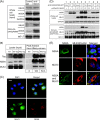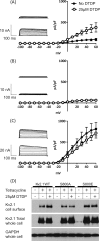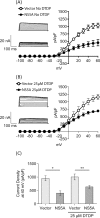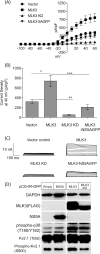Hepatitis C virus NS5A inhibits mixed lineage kinase 3 to block apoptosis
- PMID: 23857585
- PMCID: PMC3750171
- DOI: 10.1074/jbc.M113.491985
Hepatitis C virus NS5A inhibits mixed lineage kinase 3 to block apoptosis
Abstract
Hepatitis C virus (HCV) infection results in the activation of numerous stress responses including oxidative stress, with the potential to induce an apoptotic state. Previously we have shown that HCV attenuates the stress-induced, p38MAPK-mediated up-regulation of the K(+) channel Kv2.1, to maintain the survival of infected cells in the face of cellular stress. We demonstrated that this effect was mediated by HCV non-structural 5A (NS5A) protein, which impaired p38MAPK activity through a polyproline motif-dependent interaction, resulting in reduction of phosphorylation activation of Kv2.1. In this study, we investigated the host cell proteins targeted by NS5A to mediate Kv2.1 inhibition. We screened a phage-display library expressing the entire complement of human SH3 domains for novel NS5A-host cell interactions. This analysis identified mixed lineage kinase 3 (MLK3) as a putative NS5A interacting partner. MLK3 is a serine/threonine protein kinase that is a member of the MAPK kinase kinase (MAP3K) family and activates p38MAPK. An NS5A-MLK3 interaction was confirmed by co-immunoprecipitation and Western blot analysis. We further demonstrate a novel role of MLK3 in the modulation of Kv2.1 activity, whereby MLK3 overexpression leads to the up-regulation of channel activity. Accordingly, coexpression of NS5A suppressed this stimulation. Additionally we demonstrate that overexpression of MLK3 induced apoptosis, which was also counteracted by NS5A. We conclude that NS5A targets MLK3 with multiple downstream consequences for both apoptosis and K(+) homeostasis.
Keywords: Apoptosis; Hepatitis c Virus; Ion Channels; Kv2.1; Mixed Lineage Kinase 3; NS5A; Oxidative Stress; SH3 Domains.
Figures








Similar articles
-
Regulation of neuronal proapoptotic potassium currents by the hepatitis C virus nonstructural protein 5A.J Neurosci. 2012 Jun 27;32(26):8865-70. doi: 10.1523/JNEUROSCI.0937-12.2012. J Neurosci. 2012. PMID: 22745487 Free PMC article.
-
The hepatitis C virus NS5A protein binds to members of the Src family of tyrosine kinases and regulates kinase activity.J Gen Virol. 2004 Mar;85(Pt 3):721-729. doi: 10.1099/vir.0.19691-0. J Gen Virol. 2004. PMID: 14993658
-
Hepatitis C virus NS5A binds to the mRNA cap-binding eukaryotic translation initiation 4F (eIF4F) complex and up-regulates host translation initiation machinery through eIF4E-binding protein 1 inactivation.J Biol Chem. 2012 Feb 10;287(7):5042-58. doi: 10.1074/jbc.M111.308916. Epub 2011 Dec 19. J Biol Chem. 2012. PMID: 22184107 Free PMC article.
-
The nonstructural NS5A protein of hepatitis C virus: an expanding, multifunctional role in enhancing hepatitis C virus pathogenesis.J Biomed Sci. 2002 May-Jun;9(3):187-97. doi: 10.1007/BF02256065. J Biomed Sci. 2002. PMID: 12065893 Review.
-
Phosphorylation of hepatitis C virus NS5A nonstructural protein: a new paradigm for phosphorylation-dependent viral RNA replication?Virology. 2007 Jul 20;364(1):1-9. doi: 10.1016/j.virol.2007.01.042. Epub 2007 Apr 2. Virology. 2007. PMID: 17400273 Review.
Cited by
-
Requirement for chloride channel function during the hepatitis C virus life cycle.J Virol. 2015 Apr;89(7):4023-9. doi: 10.1128/JVI.02946-14. Epub 2015 Jan 21. J Virol. 2015. PMID: 25609806 Free PMC article.
-
Hepatitis C virus NS5A protein blocks epidermal growth factor receptor degradation via a proline motif- dependent interaction.J Gen Virol. 2015 Aug;96(8):2133-2144. doi: 10.1099/vir.0.000145. Epub 2015 Apr 13. J Gen Virol. 2015. PMID: 25872741 Free PMC article.
-
Mixed-lineage kinase 3 pharmacological inhibition attenuates murine nonalcoholic steatohepatitis.JCI Insight. 2017 Aug 3;2(15):e94488. doi: 10.1172/jci.insight.94488. eCollection 2017 Aug 3. JCI Insight. 2017. PMID: 28768902 Free PMC article.
-
Oxidation of KCNB1 potassium channels triggers apoptotic integrin signaling in the brain.Cell Death Dis. 2017 Apr 6;8(4):e2737. doi: 10.1038/cddis.2017.160. Cell Death Dis. 2017. PMID: 28383553 Free PMC article.
-
Identification of two distinct peptide-binding pockets in the SH3 domain of human mixed-lineage kinase 3.J Biol Chem. 2018 Aug 31;293(35):13553-13565. doi: 10.1074/jbc.RA117.000262. Epub 2018 Jul 6. J Biol Chem. 2018. PMID: 29980598 Free PMC article.
References
-
- Pawlotsky J. M. (2004) Pathophysiology of hepatitis C virus infection and related liver disease. Trends Microbiol. 12, 96–102 - PubMed
-
- Masaki T., Suzuki R., Murakami K., Aizaki H., Ishii K., Murayama A., Date T., Matsuura Y., Miyamura T., Wakita T., Suzuki T. (2008) Interaction of hepatitis C virus nonstructural protein 5A with core protein is critical for the production of infectious virus particles. J. Virol. 82, 7964–7976 - PMC - PubMed
Publication types
MeSH terms
Substances
Grants and funding
LinkOut - more resources
Full Text Sources
Other Literature Sources
Medical
Molecular Biology Databases
Miscellaneous

